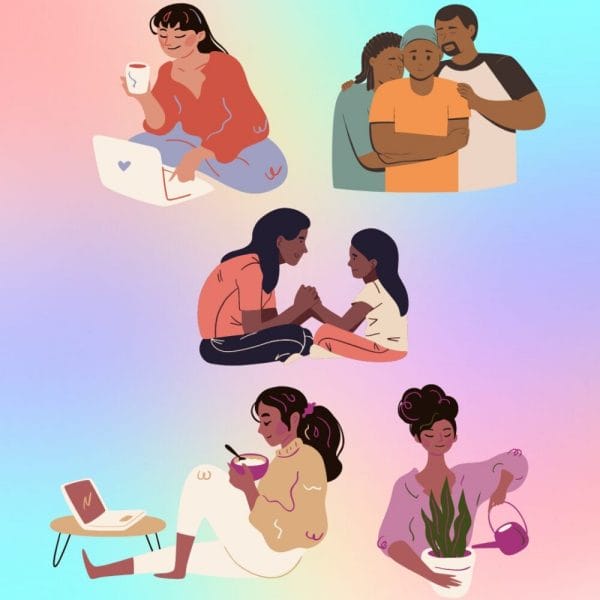How “working backwards” from health outcomes can lead to more effective health interventions
What does it mean to reverse engineer health? The concept is drawn from engineering. Software engineers commonly reverse engineer a piece of software: in order to develop a new application, they “work backwards,” deconstructing the source code of an existing application to see how it was created. Once the key ingredients are clear, engineers can reconstruct them to get the outcome they’re after. Human behavior is not software code, but an analogous process can actually be used to work backwards from health, deconstructing the components that lead to health outcomes, and reconstructing them to build more effective behavioral health interventions. We think of this as reverse engineering health.
Health outcomes have multiple, complex causes that can be addressed with a variety of strategies and levels of intervention.
At Hopelab, our focus is on individual behavior change among adolescents and young adults (AYAs). We reverse engineer health to develop tech-based interventions that leverage individual behaviors and the psychological processes underlying them to drive positive health outcomes. Here’s how it works:
- We start by identifying a health outcome we want to improve. We focus on areas where there is significant unmet need and where meaningful improvement would allow teens and young adults to live happier, healthier lives. We’ve targeted a range of outcomes including decreased risk for obesity or depression, and improved survival rates for young people diagnosed with cancer.
- Next, we identify the key behavioral and psychological drivers of that health outcome, asking whether and how technology might be leveraged to specifically target those drivers.
- Finally, we work to “reconstruct” the positive outcome, creating tech-based interventions that are specifically designed to target the key behavioral and psychological drivers of the health outcome we’re after.
Just as with reverse engineering software, this “reverse engineering health” approach provides targets to test at every step. This allows for important mid-stream course correction, testing whether we’re hitting the psychological and behavioral targets we designed for, and using the early test results to course-correct as we go. If we don’t get it completely right the first time, this process allows us to efficiently and effectively identify issues, learn from what’s not working, and make improvements on the next iteration.
Below, we’ll share some examples of the unlikely products that have emerged from this process to show how it can be applied to the development of new, high-impact health interventions and products.
Case Study #1 Play, Fight, Win: The Story of Re-Mission
Hopelab’s founding intervention, the video game Re-Mission, targeted a health outcome both simple and profound—to increase the survival rate of young people diagnosed with cancer. We know there are many factors contributing to cancer survival rates in teens and young adults, including barriers to care, the costs and coverage restrictions of healthcare, even unique biological processes; but powerful behavioral drivers are also at play. One of the most important behavioral drivers among young people is active engagement in one’s own medical care—which includes strict adherence to often complex medication regimens, timely symptom reporting, and communication with the care team.
In order to reverse engineer the survival rate of young people diagnosed with cancer, we needed to target the psychological drivers that lead youth to engage actively in their own medical care. Through many rounds of iterative work, including behavioral science literature reviews, expert consults, novel experiments, and—most importantly—hundreds of hours of deep listening with young people and their families and care teams, we identified a potent combination of emotion and motivation that contributes to young people’s adherence to, and engagement with, their medical care. As an overarching construct, self-efficacy (i.e., a sense of power and agency in one’s treatment journey and feeling confident in one’s ability to take the actions needed) was a key psychological driver of target health behaviors.
This is where technology comes in. A robust body of research points to the power of games to influence health behaviors. It turns out, video game mechanics and play-based interventions are fantastic tools for activating emotion and motivation and boosting self-efficacy. The result was Re-Mission, the first videogame created and validated to significantly increase medication adherence for teens and young adults with cancer. In Re-Mission, young players control a nanobot that flies through the immersive inner world of fictional young people with cancer and they use the real-world weapons of cancer treatment—chemotherapy, radiation, antibiotics—to root out rogue cancer cells, head off metastases, blast away at infections, and win the fight.
The process took time and required empathy, precision, and iteration in equal measure, but it taught us that reverse engineering works. Ultimately, a multi-national randomized controlled trial (RCT) showed that Re-Mission significantly improved self-efficacy and medication adherence in young people with cancer. For a deeper dive into the reverse engineering of Re-Mission, check out the Re-Mission page.
Case Study #2. To Move Me, You’ve Gotta Understand Me: Zamzee
Zamzee—a behavioral intervention that pairs a wearable, kid-optimized accelerometer with a motivational website designed to get tweens aged 11-14 more physically active—targeted sedentary behavior and the growing rates of childhood obesity in the United States and throughout the world. Specifically, the aim was to reduce the risk of childhood obesity and the development of diseases associated with sedentary behavior (like Type 2 diabetes and cardiovascular disease). Decades of evidence point to behavioral factors shown to be protective against obesity, chief among them, increased minutes of moderate-to-vigorous physical activity (MVPA) and decreased sedentary behavior.
So how do you get tweens to be more physically active at exactly the age when, for many kids, both play and time spent moving in general are declining? To answer this, we needed to understand the lived experience of many self-described “non-athletic” tweens—especially those statistically most at risk for long-term health problems, including girls, youth of color, and those without access to safe, accessible outdoor space. Here we focused on the powerful psychological driver of intrinsic motivation: turning movement into fun; boosting autonomy by rewarding self-selected and obtainable activity (not just sports); and making the intervention aspirational, purposeful, and game-like. From these principles, Zamzee was born—an intervention that balanced small extrinsic rewards like points redeemable for rewards, with lots of intrinsic motivation at every turn. Multiple experimental studies during iterative build-test cycles culminated in a multi-site RCT of over 300 diverse middle school aged kids. The result: Zamzee increased physical activity in these tweens by 59% on average over the six-month study period and had positive impacts on metabolic risk factors associated with heart disease and diabetes. To learn more, check out the Zamzee page.
Case Study #3. What’s Your Goal Mama? A Digital Platform to Amplify a Public Health Program’s Impact
In the case of Goal Mama—a digital platform designed to help the young moms and nurses of the Nurse-Family Partnership (NFP) program to better set goals, track progress, and celebrate success—our target outcome was increasing engagement and retention in the NFP program. Findings from decades of randomized evaluation studies have shown that participation in the two-and-half-year NFP program results in a powerful set of positive health and life outcomes for low income, first-time moms and their babies. But much like medication adherence for cancer, moms need to stick with the program to benefit from it.
To reverse engineer these health behaviors (showing up for visits, remaining an active participant in the program, etc.), we needed to target the psychological drivers that made the program compelling and motivating to these young mothers. Collaborative work with nurses, program leadership, and moms themselves pointed to a high-potential target: when moms and nurses were deeply engaged in goal setting together, and when nurses were actively supporting moms in achieving their goals and dreams, moms were more likely to stay in the program. And critically, when this was done in the context of a warm, supportive, effective relationship between nurse and mom, then it really worked.
Building on these insights, Goal Mama was born. Together with nurses and moms, we co-designed a digital platform for moms to set short- and long-term goals—creating incremental steps, tracking progress, and setting reminder notifications to help moms stay focused on a path towards success and to feel the support of their nurse through every step in the journey. Goals can range from eating more healthy foods during pregnancy to obtaining baby’s immunizations on time to finishing high school. The Goal Mama platform fosters a deep connection between a mom and her nurse that supports them in setting goals, celebrating small wins, and achieving mom’s dreams together in a way that is accessible, fresh, and relevant for today’s digital native young women. To learn more about the digital platform and the first pilot study check out the Goal Mama page.
Moving the needle on health behavior; moving the needle on outcomes
From video games to apps to chatbots, Hopelab has created a broad range of science-based interactive technologies by reverse engineering health. It’s been our experience that this approach to digital health product development can be a game-changer, by systematically combining the strengths of methodical engineering for outcomes with the real heart of innovation—the voices, motivations, hopes and struggles of those whose health we aim to support. Our hope is that it can serve as a jumping off point for others who create interventions or technologies to improve human health and well-being.




